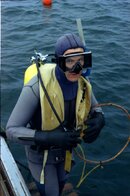Thalassamania,I do not disagree with Hilbert's opinion, in fact I worked at the NAUDC for years. What I object to is Dennis' misleading statement that implies that even properly conducted BB my be fatal because divers hold their breath and thus overpressurize to the point of AGE while still involved in BB. The locked glottis and AGE has ALWAYS occurred as a result of the failure of the BB activity and the subsequent separation of the buddies coupled with the inability to the perform a CESA. Hilbert would have been equally correct to say had both buddies been adequately trained and practiced in BB, then they'd (almost by definition) be alive today. The octopus is a better solution, but in many ways is also a possibly appropriate equipment solution to a skill problem.
'Breath hold' is a non technical term that opens a rats' nest of semantic problems when you try to pin down the details.
I just was looking through my old dive logs, and noticed this entry from a research dive that I participated in. We were diving in Yaquina Bay on September 15, 1975. Between 10:24 and 12:03 I conducted 5 dives for 56 minutes, at a depth of 44 feet. The purpose of the dives was "Subtidal dredging," which meant we dove down to the bottom with a iron ring, which allowed us to dredge out a 3 square foot circle of bottom, looking for all the clams in the sediment. We got about 6-18 large clams, and there were a large number of smaller ones. On this particular dive, I was going down to photograph the dredging operation with my Nikonos. We had a current of 0-2 knots, and visibility of 10 feet. In my "Remarks" section, I wrote this entry:
As can be seen, this was at the time considered a rather routine part of the dive. There was no incident noted, and contrary to the text that I quoted from Dennis Graver, we did not consider it life threatening. Ascent was "normal" in that I did not note any problems at all. So what I said about what Dennis wrote is a bit off from what my actual experience was years ago. As I said, this little sheet was more for discussion during the ITC than anything. But note that buddy breathing has been routinely conducted as part of a dive, and this dive shows that this happened.Photography Dives -- Ran out of air on last dive. Buddy breathed ~ 5 min -- long enough to get the photos needed.
The enclosed photo is one I just found in my negatives, and shows Limons Otis, a research biologist with the Oregon Department of Fish and Wildlife, with the ring we used for dredging. The float is attached to the dredge, which was at that point still on the bottom. We went to different areas to determine the density of clams in the bottom in Yaquina Bay. It was a very interesting summer.
It is very nice to have a detailed dive log to go back to on a cold winter day, years later.
SeaRat




